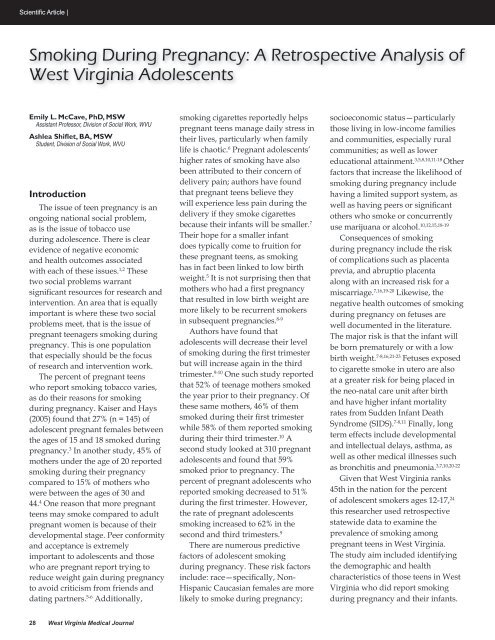Adam E. Klein, MD - West Virginia State Medical Association
Adam E. Klein, MD - West Virginia State Medical Association
Adam E. Klein, MD - West Virginia State Medical Association
You also want an ePaper? Increase the reach of your titles
YUMPU automatically turns print PDFs into web optimized ePapers that Google loves.
Scientific Article |Smoking During Pregnancy: A Retrospective Analysis of<strong>West</strong> <strong>Virginia</strong> AdolescentsEmily L. McCave, PhD, MSWAssistant Professor, Division of Social Work, WVUAshlea Shiflet, BA, MSWStudent, Division of Social Work, WVUIntroductionThe issue of teen pregnancy is anongoing national social problem,as is the issue of tobacco useduring adolescence. There is clearevidence of negative economicand health outcomes associatedwith each of these issues. 1,2 Thesetwo social problems warrantsignificant resources for research andintervention. An area that is equallyimportant is where these two socialproblems meet, that is the issue ofpregnant teenagers smoking duringpregnancy. This is one populationthat especially should be the focusof research and intervention work.The percent of pregnant teenswho report smoking tobacco varies,as do their reasons for smokingduring pregnancy. Kaiser and Hays(2005) found that 27% (n = 145) ofadolescent pregnant females betweenthe ages of 15 and 18 smoked duringpregnancy. 3 In another study, 45% ofmothers under the age of 20 reportedsmoking during their pregnancycompared to 15% of mothers whowere between the ages of 30 and44. 4 One reason that more pregnantteens may smoke compared to adultpregnant women is because of theirdevelopmental stage. Peer conformityand acceptance is extremelyimportant to adolescents and thosewho are pregnant report trying toreduce weight gain during pregnancyto avoid criticism from friends anddating partners. 5-6 Additionally,smoking cigarettes reportedly helpspregnant teens manage daily stress intheir lives, particularly when familylife is chaotic. 6 Pregnant adolescents’higher rates of smoking have alsobeen attributed to their concern ofdelivery pain; authors have foundthat pregnant teens believe theywill experience less pain during thedelivery if they smoke cigarettesbecause their infants will be smaller. 7Their hope for a smaller infantdoes typically come to fruition forthese pregnant teens, as smokinghas in fact been linked to low birthweight. 5 It is not surprising then thatmothers who had a first pregnancythat resulted in low birth weight aremore likely to be recurrent smokersin subsequent pregnancies. 8-9Authors have found thatadolescents will decrease their levelof smoking during the first trimesterbut will increase again in the thirdtrimester. 9-10 One such study reportedthat 52% of teenage mothers smokedthe year prior to their pregnancy. Ofthese same mothers, 46% of themsmoked during their first trimesterwhile 58% of them reported smokingduring their third trimester. 10 Asecond study looked at 310 pregnantadolescents and found that 59%smoked prior to pregnancy. Thepercent of pregnant adolescents whoreported smoking decreased to 51%during the first trimester. However,the rate of pregnant adolescentssmoking increased to 62% in thesecond and third trimesters. 9There are numerous predictivefactors of adolescent smokingduring pregnancy. These risk factorsinclude: race—specifically, Non-Hispanic Caucasian females are morelikely to smoke during pregnancy;socioeconomic status—particularlythose living in low-income familiesand communities, especially ruralcommunities; as well as lowereducational attainment. 3,5,8,10,11-18 Otherfactors that increase the likelihood ofsmoking during pregnancy includehaving a limited support system, aswell as having peers or significantothers who smoke or concurrentlyuse marijuana or alcohol. 10,12,15,18-19Consequences of smokingduring pregnancy include the riskof complications such as placentaprevia, and abruptio placentaalong with an increased risk for amiscarriage. 7,16,19-20 Likewise, thenegative health outcomes of smokingduring pregnancy on fetuses arewell documented in the literature.The major risk is that the infant willbe born prematurely or with a lowbirth weight. 7-8,16,21-23 Fetuses exposedto cigarette smoke in utero are alsoat a greater risk for being placed inthe neo-natal care unit after birthand have higher infant mortalityrates from Sudden Infant DeathSyndrome (SIDS). 7-8,11 Finally, longterm effects include developmentaland intellectual delays, asthma, aswell as other medical illnesses suchas bronchitis and pneumonia. 3,7,10,20-22Given that <strong>West</strong> <strong>Virginia</strong> ranks45th in the nation for the percentof adolescent smokers ages 12-17, 24this researcher used retrospectivestatewide data to examine theprevalence of smoking amongpregnant teens in <strong>West</strong> <strong>Virginia</strong>.The study aim included identifyingthe demographic and healthcharacteristics of those teens in <strong>West</strong><strong>Virginia</strong> who did report smokingduring pregnancy and their infants.28 <strong>West</strong> <strong>Virginia</strong> <strong>Medical</strong> Journal















